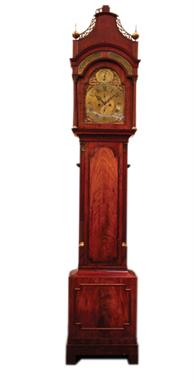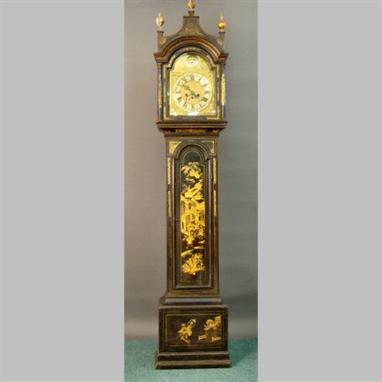A late 19th century/early 20th century mahogany inlaid eight-day longcase clock, the arched brass dial with a silvered chapter ring and subsidiary seconds dial, the three train movement with Whittington and Westminster chimes, striking on eight bells, and a single gong, crossbanded with satinwood and inlaid with a vase, bell flowers and ribbons. Dial 28.5cm (111Ú4 in) Case 181cm high Visit www.sworder.co.uk for larger image and condition reports.
We found 44425 price guide item(s) matching your search
There are 44425 lots that match your search criteria. Subscribe now to get instant access to the full price guide service.
Click here to subscribe- List
- Grid
-
44425 item(s)/page
Richard Houton, Oversley Green, an oak longcase clock, the square brass dial with a silvered chapter ring, the movement now with three trains, striking the hours and quarters on eight bells, the case later carved, the movement altered. Dial 25cm diameter (10in) Case 205cm high Visit www.sworder.co.uk for larger image and condition reports.
An 18th century mahogany eight-day longcase clock, the 12" brass dial with an arched top, strike silent, date and calendar rings and four seasons spandrels, now in a mahogany case with inlaid `fan` decoration and quarter fluted columns. 209cm high (to top of finial) Visit www.sworder.co.uk for larger image and condition reports.
A GEORGE III BRASS FACED EIGHT DAY LONGCASE CLOCK, the brass dial with subsidiary seconds dial and date aperture, with an arched top decorated with an engraved basket of flowers, with an eight day two train movement striking on a bell, the hood with swan-neck pediment, the trunk with a short door inlaid with a central shell motif, flanked by quarter recessed fluted columns, 86" high. See illustration
A GEORGE III MAHOGANY LONGCASE CLOCK, the brass dial signed "Ste Leuit, Chelmsford", with subsidiary seconds dial and date aperture, the chapter ring with Roman numerals and pierced spandrels, the five pillar eight day movement striking on a bell, the flat topped hood above stop-fluted columns, the trunk door with arched top and inlay, 82" high
A GEORGE III MAHOGANY LONGCASE CLOCK, the case with a long arched door flanked by quarter fluted columns above a plinth with canted corners, on ogee bracket feet, the blind fretwork carved hood with corinthian columns and arch shaped pediment with brass ball and spear finials, the circular brass dial engraved with masonic emblem, Roman and Arabic numerals to the chapter ring with two train movement striking on a bell, c.90" high. See illustration
A GEORGE III MAHOGANY LONGCASE CLOCK by Eliezer & James Chater of London, the brass dial with silver chapter ring and subsidiary seconds dial and date aperture, the arch with a strike/silent dial, with a fiver pillar eight-day movement striking on a bell, the mahogany case with a tall trunk door flanked by fluted quarter columns, 88?" high. See illustration
AN EARLY 19TH CENTURY SCOTTISH LONGCASE CLOCK by James Conan of Edinburgh, the dial with a matted centre and subsidiary seconds dial and date aperture, with a silvered chapter ring with Roman numerals, beneath an arch with maker`s name flanked by dolphin spandrels, with an eight-day movement striking on a bell, the hood with scrolling pediment and turned columns, the trunk with conforming applied half columns and bow fronted door, 83" high. See illustration
JOHN SLYE OF WEYMOUTH: A GEORGE III MAHOGANY LONGCASE CLOCK, with a silvered dial with subsidiary seconds and date dials and fan engraved spandrels, the arch with a rocking ship automaton "The Neptune", with a two-train eight-day movement striking on a bell, the hood with three ball finials and stop-fluted columns, the trunk with an arch topped door with conforming canted stop-fluted columns, 93" high. See illustration
A GEORGE III MAHOGANY LONGCASE CLOCK inscribed "John Taylor, London ", with a five pillar eight day bell striking movement, the brass dial with an arch with strike/silent indicator and the centre with seconds and date dials, in a flame-figured mahogany case with brass-capped corinthian capitals to the quarter pilasters, 105" high. See illustration
An early 19th century oak and mahogany eight day longcase clock, the arched painted enamel dial signed by Joseph Walker of Workington, the crossbanded door flanked by cluster columns, on turned bun feet. This lot is accompanied by a significant amount of information about Joseph Walker and the Walker family, compiled by the present owner who has owned the clock for more than 30 years. Joseph Walker is believed to have been born in Kirkcudbright in 1790 and died in Workington in 1858, from a family of watch and clock makers (Illustrated).
An early 18th century Dutch eight day musical longcase clock, with seaweed marquetry decorated walnut case and arched 12 inch brass dial with six tune selector in the arch, movement playing on 8 bells, silvered Roman chapter ring, subsidiary seconds and date aperture, signed Pieter Kloch, Amsterdam, the trunk door inset with a silvered plate mercury thermometer, the hood applied with giltwood figures of Atlas and angels, 8ft 5ins
A good George II blue Japanned longcase clock, having a pagoda hood with gilt finial`s housing a brass arched dial with a silvered chapter ring, Roman numerals and date aperture flanked by brass spandrels, the twin train movement striking on a bell signed John Hall of Beverley, the trunk enclosed by an arched door on a stepped plinth base, 240cm tall
Thomas Kirk of Hull, a 19th century mahogany and inlaid longcase clock, the painted face with date aperture and secondary dial supporting a twin train striking movement under an arched hood with swans neck pediment, the trunk with ogee shaped door and reeded angles on a plain base with swept bracket feet
An 18th Century oak longcase clock with a 30-hour movement, the hood with plain pillar supports and cornice pediment enclosing the 10” square foliate-engraved brass dial with figural spandrels, date aperture and Roman numeral chapter ring which bears the signature Henry Buxton. Measuring 192cm high, some damages and later repairs.
A late 18th century mahogany longcase clock, By J.W. Nicholson & Son, with twin train movement, the painted arched dial depicting a maiden water carrier and spandrels, Roman numerals, subsidiary second and date dials, the hood with swan neck pediment, pilasters, bowfronted trunk door flanked by pilasters, panelled base with serpentine apron, raised on bracket feet, 210cm high
A George III longcase clock, By William Hendrie, Airdrie, the arched brass dial with chapter ring, Arabic and Roman numerals , subsidiary second dial, date apperture, eight day movement, later pediment, spirally turned columns, beaded trunk door with star inlay, flanked by spirally turned quartered columns, beaded plinth base, raised on bracket feet, 218cm high
A 19th century heavily carved oak longcase clock, By Thomas Lister, the square face with Roman numerals, subsidiary second dial and date aperture, brass spandrels, eight day movement, the projected moulded cornice over spirally turned columns with brass capitals, trunk door, plinth base, raised on bracket feet, 210cm high
A George III mahogany longcase clock, By Shapland and Petter, the arched enamel and painted dial depicting a hunting scene, Arabic numerals, subsidiary second dial and date aperture, eight day movement, the swan neck pediment with urn finial, Corinthian columns, crossbanded shell inlay trunk door, crossbanded plinth base, shaped apron, raised on bracket feet, 220cm high
A George IV Scottish mahogany longcase clock, J. Melrose, Edinburgh, the white painted dial surmounted by a castle view, with subsidiary second and date dials, with an eight-day bell striking movement, the hood with broken swan neck pediment and fluted pilasters, the crossbanded case raised on shaped bracket feet, 48cm wide, 211cm high, 24cm deep
A George III mahogany longcase clock, By J Campbell, the arched enamelled and painted dial, with Arabic numerals, subsidiary second dial, eight day movement, the swan neck pediment over fluted Doric columns, moulded trunk door, flanked by fluted quarter columns, plinth base raised on bracket feet, 237cm high
"RICHARD SWAIN, STRATFORD, AN EARLY 19TH CENTURY OAK LONGCASE CLOCK, the hood having a moulded and carved pediment with twin flank ring pilasters, waist panel door and box base on later shoe, the 30 hour mechanism with four pillars and anchor escapeme"nt faced by a square painted dial with floral spandrels and Roman chapter, 2.15m high
"W** WILKINSON, PENRITH, AN EARLY 19TH CENTURY OAK, ELM AND MAHOGANY VENEERED LONGCASE CLOCK, the hood with later applied moulded pediment, period brass capped pilasters, the trunk with arched panel door on box plinth, 30 hour mechanism, 4 pillar with" anchor escapement and count wheel strike on bell, faced by square painted dial with Arabic and Roman chapter, 2m high
A George III mahogany longcase clock with eight day movement striking on a bell, the painted breakarch dial with subsidiary seconds, date aperture and inscribed `Symonds Reepham`, the breakarch painted with birds above floral spandrels, the arched hood with gilt finials above a blazed door and turned columns, the trunk with arched door on a plinth base, height approx 210cm, together with pendulum and two weights (alterations).
A George III figured mahogany longcase clock with eight day movement striking on a bell, the gilt break arch dial with silvered chapter ring and centre, subsidiary seconds dial, date aperture and inscribed `William Avenell, Portsmouth`, beneath rocking Father Time automaton to arch, the hood with swan neck pediment above a glazed door flanked by fluted columns, the rectangular trunk door with shell paterae inlay, on a plain base and bracket feet, height approx 222cm, with pendulum and weights.
A George III oak longcase clock with thirty hour movement striking on a bell, the square brass dial with subsidiary seconds and inscribed `Budgen Croydon`, the hood with swan neck pediment above a glazed door flanked by turned columns, the trunk with arched door, on a plain base and bracket feet, height approx 214cm, together with weight and pendulum.
A George III oak longcase clock with eight day movement striking on a bell, the square brass dial with subsidiary seconds, dater aperture and inscribed `Phillips Tenbury`, the hood with glazed door flanked by columns, the crossbanded rectangular trunk door on a plain base and bracket feet, height approx 205cm, with two weights and pendulum (alterations and restoration).
A mid-18th Century oak longcase clock with eight day striking movement, the brass dial with Roman numerals, subsidiary seconds and date aperture, the hood with moulded pediment above a glazed door and turned columns, the arched trunk door with glazed lenticle, above a plain base and bracket feet, height approx 201cm, together with pendulum (lacking weights and faults).
-
44425 item(s)/page
























